新工质 R134a 在水平强化管外的池沸腾换热
- 格式:pdf
- 大小:258.19 KB
- 文档页数:4
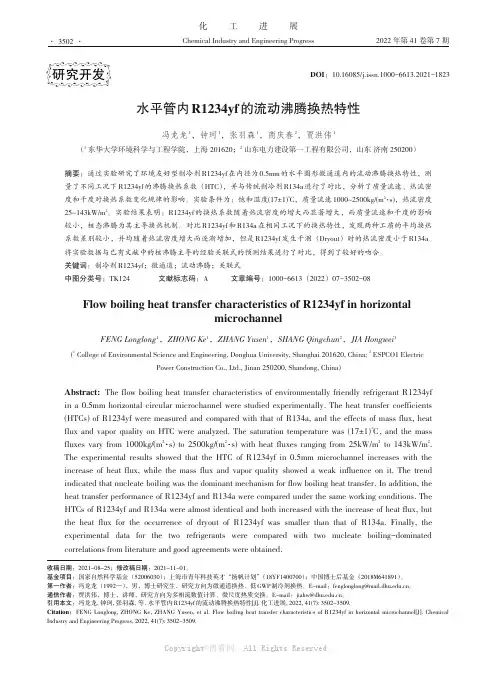
化工进展Chemical Industry and Engineering Progress2022年第41卷第7期水平管内R1234yf 的流动沸腾换热特性冯龙龙1,钟珂1,张羽森1,商庆春2,贾洪伟1(1东华大学环境科学与工程学院,上海201620;2山东电力建设第一工程有限公司,山东济南250200)摘要:通过实验研究了环境友好型制冷剂R1234yf 在内径为0.5mm 的水平圆形微通道内的流动沸腾换热特性,测量了不同工况下R1234yf 的沸腾换热系数(HTC ),并与传统制冷剂R134a 进行了对比,分析了质量流速、热流密度和干度对换热系数变化规律的影响。
实验条件为:饱和温度(17±1)℃,质量流速1000~2500kg/(m 2·s),热流密度25~143kW/m 2。
实验结果表明:R1234yf 的换热系数随着热流密度的增大而显著增大,而质量流速和干度的影响较小,核态沸腾为其主导换热机制。
对比R1234yf 和R134a 在相同工况下的换热特性,发现两种工质的平均换热系数差别较小,并均随着热流密度增大而逐渐增加,但是R1234yf 发生干涸(Dryout )时的热流密度小于R134a 。
将实验数据与已有文献中的核沸腾主导的经验关联式的预测结果进行了对比,得到了较好的吻合。
关键词:制冷剂R1234yf ;微通道;流动沸腾;关联式中图分类号:TK124文献标志码:A文章编号:1000-6613(2022)07-3502-08Flow boiling heat transfer characteristics of R1234yf in horizontalmicrochannelFENG Longlong 1,ZHONG Ke 1,ZHANG Yusen 1,SHANG Qingchun 2,JIA Hongwei 1(1College of Environmental Science and Engineering,Donghua University,Shanghai 201620,China;2ESPCO1ElectricPower Construction Co.,Ltd.,Jinan 250200,Shandong,China)Abstract:The flow boiling heat transfer characteristics of environmentally friendly refrigerant R1234yf in a 0.5mm horizontal circular microchannel were studied experimentally.The heat transfer coefficients (HTCs)of R1234yf were measured and compared with that of R134a,and the effects of mass flux,heat flux and vapor quality on HTC were analyzed.The saturation temperature was (17±1)℃,and the mass fluxes vary from 1000kg/(m 2·s)to 2500kg/(m 2·s)with heat fluxes ranging from 25kW/m 2to 143kW/m 2.The experimental results showed that the HTC of R1234yf in 0.5mm microchannel increases with the increase of heat flux,while the mass flux and vapor quality showed a weak influence on it.The trend indicated that nucleate boiling was the dominant mechanism for flow boiling heat transfer.In addition,the heat transfer performance of R1234yf and R134a were compared under the same working conditions.The HTCs of R1234yf and R134a were almost identical and both increased with the increase of heat flux,but the heat flux for the occurrence of dryout of R1234yf was smaller than that of R134a.Finally,the experimental data for the two refrigerants were compared with two nucleate boiling-dominated correlations from literature and good agreements were obtained.研究开发DOI :10.16085/j.issn.1000-6613.2021-1823收稿日期:2021-08-25;修改稿日期:2021-11-01。
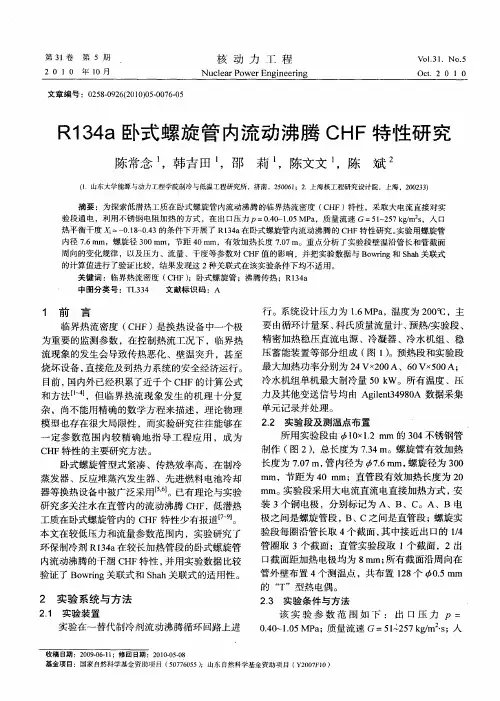
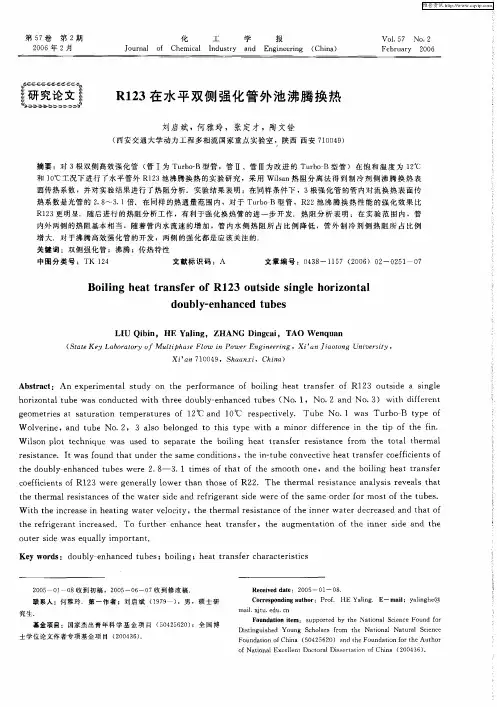
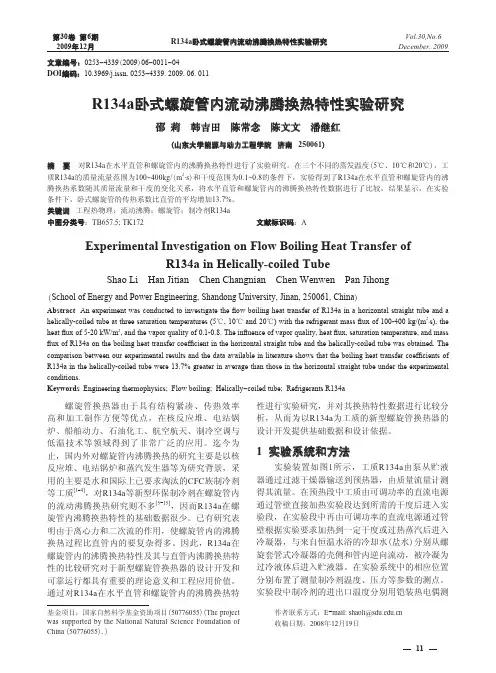
文章编号:0253-4339(2009)06-0011-04DOI编码:10.3969/j.issn. 0253-4339. 2009. 06. 011R134a卧式螺旋管内流动沸腾换热特性实验研究邵莉韩吉田陈常念陈文文潘继红(山东大学能源与动力工程学院济南 250061)摘要对R134a在水平直管和螺旋管内的沸腾换热特性进行了实验研究。
在三个不同的蒸发温度(5℃、10℃和20℃),工质R134a的质量流量范围为100~400kg/(m2.s)和干度范围为0.1~0.8的条件下,实验得到了R134a在水平直管和螺旋管内的沸腾换热系数随其质量流量和干度的变化关系,将水平直管和螺旋管内的沸腾换热特性数据进行了比较,结果显示,在实验条件下,卧式螺旋管的传热系数比直管的平均增加13.7%。
关键词工程热物理;流动沸腾;螺旋管;制冷剂R134a中图分类号:TB657.5; TK172 文献标识码:AExperimental Investigation on Flow Boiling Heat Transfer ofR 3 a in Helically-coiled TubeShao Li Han Jitian Chen Changnian Chen Wenwen Pan Jihong(School of Energy and Power Engineering, Shandong University, Jinan, 250061, China)Abstract An experiment was conducted to investigate the flow boiling heat transfer of R134a in a horizontal straight tube and a helically-coiled tube at three saturation temperatures (5℃, 10℃ and 20℃) with the refrigerant mass flux of 100-400 kg/(m2.s), the heat flux of 5-20 kW/m2, and the vapor quality of 0.1-0.8. The influence of vapor quality, heat flux, saturation temperature, and mass flux of R134a on the boiling heat transfer coefficient in the horizontal straight tube and the helically-coiled tube was obtained. The comparison between our experimental results and the data available in literature shows that the boiling heat transfer coefficients of R134a in the helically-coiled tube were 13.7% greater in average than those in the horizontal straight tube under the experimental conditions.Keywords Engineering thermophysics; Flow boiling; Helically-coiled tube; Refrigerants R134a螺旋管换热器由于具有结构紧凑、传热效率高和加工制作方便等优点,在核反应堆、电站锅炉、船舶动力、石油化工、航空航天、制冷空调与低温技术等领域得到了非常广泛的应用。
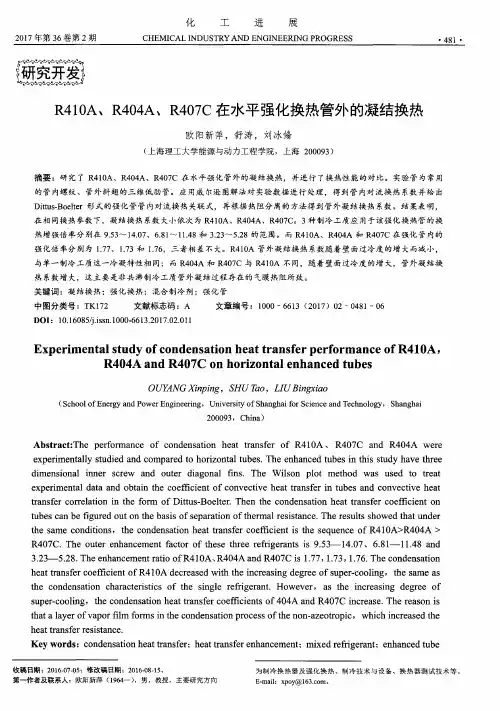
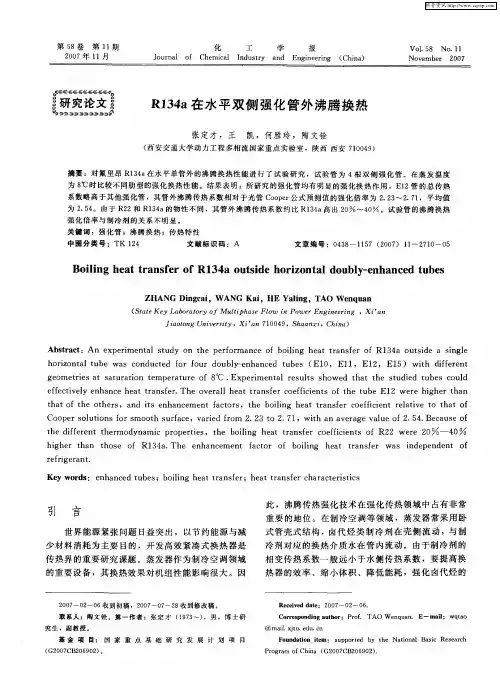
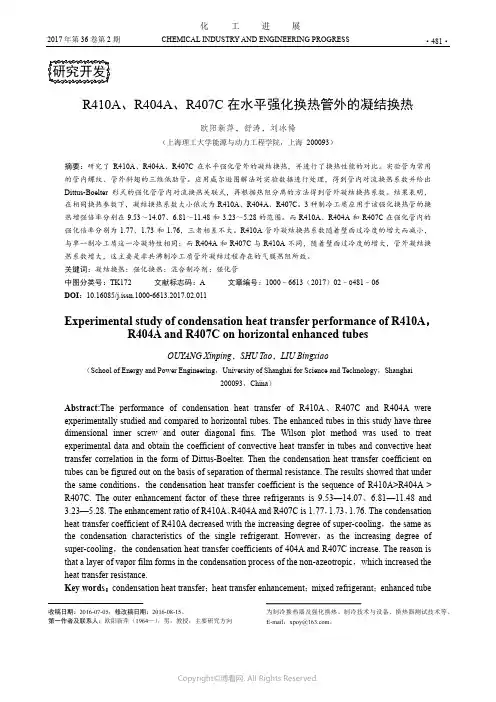
2017年第36卷第2期 CHEMICAL INDUSTRY AND ENGINEERING PROGRESS·481·化 工 进 展R410A 、R404A 、R407C 在水平强化换热管外的凝结换热欧阳新萍,舒涛,刘冰翛(上海理工大学能源与动力工程学院,上海 200093)摘要:研究了R410A 、R404A 、R407C 在水平强化管外的凝结换热,并进行了换热性能的对比。
实验管为常用的管内螺纹、管外斜翅的三维低肋管。
应用威尔逊图解法对实验数据进行处理,得到管内对流换热系数并给出Dittus-Boelter 形式的强化管管内对流换热关联式,再根据热阻分离的方法得到管外凝结换热系数。
结果表明,在相同换热参数下,凝结换热系数大小依次为R410A 、R404A 、R407C 。
3种制冷工质应用于该强化换热管的换热增强倍率分别在9.53~14.07、6.81~11.48和3.23~5.28的范围。
而R410A 、R404A 和R407C 在强化管内的强化倍率分别为1.77、1.73和1.76,三者相差不大。
R410A 管外凝结换热系数随着壁面过冷度的增大而减小,与单一制冷工质这一冷凝特性相同;而R404A 和R407C 与R410A 不同,随着壁面过冷度的增大,管外凝结换热系数增大,这主要是非共沸制冷工质管外凝结过程存在的气膜热阻所致。
关键词:凝结换热;强化换热;混合制冷剂;强化管中图分类号:TK172 文献标志码:A 文章编号:1000–6613(2017)02–0481–06DOI :10.16085/j.issn.1000-6613.2017.02.011Experimental study of condensation heat transfer performance of R410A ,R404A and R407C on horizontal enhanced tubesOUYANG Xinping ,SHU Tao ,LIU Bingxiao(School of Energy and Power Engineering ,University of Shanghai for Science and Technology ,Shanghai200093,China )Abstract:The performance of condensation heat transfer of R410A 、R407C and R404A were experimentally studied and compared to horizontal tubes. The enhanced tubes in this study have three dimensional inner screw and outer diagonal fins. The Wilson plot method was used to treat experimental data and obtain the coefficient of convective heat transfer in tubes and convective heat transfer correlation in the form of Dittus-Boelter. Then the condensation heat transfer coefficient on tubes can be figured out on the basis of separation of thermal resistance. The results showed that under the same conditions ,the condensation heat transfer coefficient is the sequence of R410A>R404A > R407C. The outer enhancement factor of these three refrigerants is 9.53—14.07、6.81—11.48 and 3.23—5.28. The enhancement ratio of R410A 、R404A and R407C is 1.77,1.73,1.76. The condensation heat transfer coefficient of R410A decreased with the increasing degree of super-cooling ,the same as the condensation characteristics of the single refrigerant. However ,as the increasing degree of super-cooling ,the condensation heat transfer coefficients of 404A and R407C increase. The reason is that a layer of vapor film forms in the condensation process of the non-azeotropic ,which increased the heat transfer resistance.Key words :condensation heat transfer ;heat transfer enhancement ;mixed refrigerant ;enhanced tube为制冷换热器及强化换热、制冷技术与设备、换热器测试技术等。

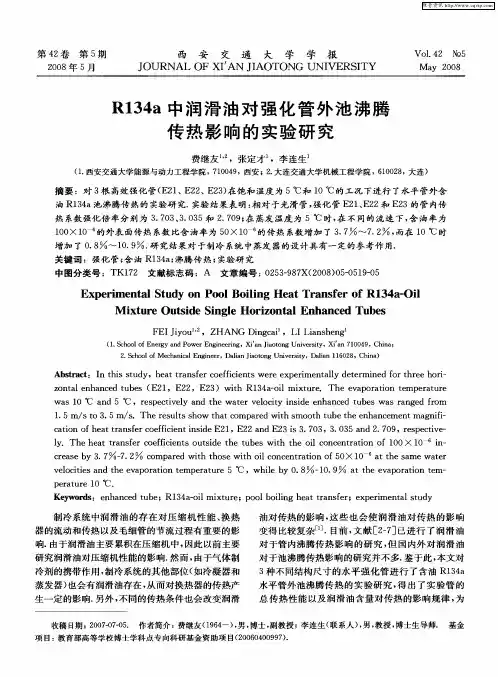
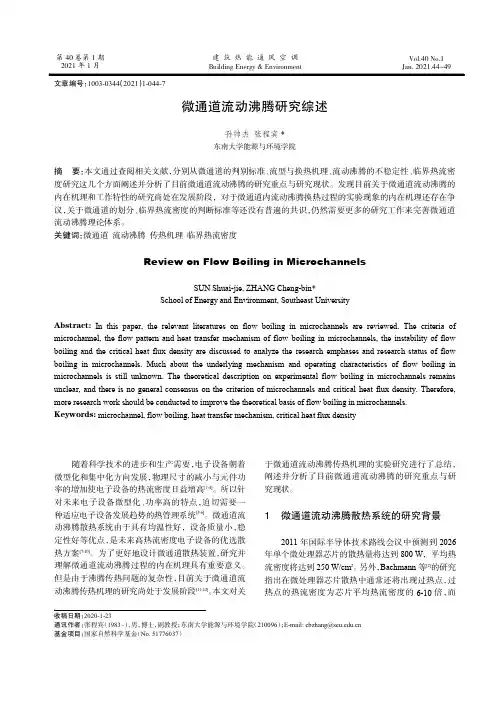
微通道流动沸腾研究综述孙帅杰 张程宾*东南大学能源与环境学院摘 要: 本文通过查阅相关文献, 分别从微通道的判别标准、 流型与换热机理、 流动沸腾的不稳定性、 临界热流密 度研究这几个方面阐述并分析了目前微通道流动沸腾的研究重点与研究现状。
发现目前关于微通道流动沸腾的 内在机理和工作特性的研究尚处在发展阶段,对于微通道内流动沸腾换热过程的实验现象的内在机理还存在争 议, 关于微通道的划分、 临界热流密度的判断标准等还没有普遍的共识, 仍然需要更多的研究工作来完善微通道 流动沸腾理论体系。
关键词: 微通道 流动沸腾 传热机理 临界热流密度Review on Flow Boiling in MicrochannelsSUN Shuaijie,ZHANG Chengbin*School of Energy and Environment,Southeast UniversityAbstract: In this paper,the relevant literatures on flow boiling in microchannels are reviewed.The criteria of microchannel,the flow pattern and heat transfer mechanism of flow boiling in microchannels,the instability of flow boiling and the critical heat flux density are discussed to analyze the research emphases and research status of flow boiling in microchannels.Much about the underlying mechanism and operating characteristics of flow boiling in microchannels is still unknown.The theoretical description on experimental flow boiling in microchannels remains unclear,and there is no general consensus on the criterion of microchannels and critical heat flux density.Therefore, more research work should be conducted to improve the theoretical basis of flow boiling in microchannels.Keywords:microchannel,flow boiling,heat transfer mechanism,critical heat flux density收稿日期: 2020123 通讯作者: 张程宾 (1983~), 男, 博士, 副教授; 东南大学能源与环境学院 (210096); Email:***************.cn 基金项目: 国家自然科学基金 (No.51776037)随着科学技术的进步和生产需要, 电子设备朝着 微型化和集中化方向发展, 物理尺寸的减小与元件功率的增加使电子设备的热流密度日益增高 [14]。
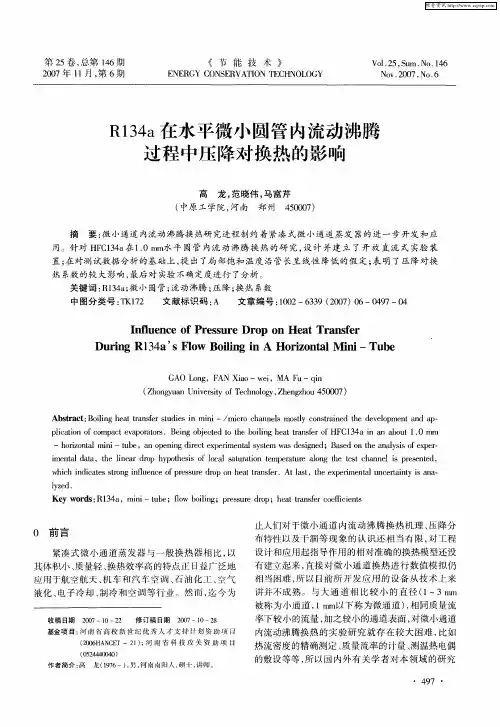
自然冷却均温板数值模拟胡琳娜;李强【摘要】为实现电子设备无噪声、高均温的温度控制,设计了1种新型自然冷却均温板.在均温板内设置两相流体管路,通过管路中工质的相变换热,强化均温板的传热性能与均温特性.通过经典相变理论并结合流体体积函数方程建立自然冷却均温板的流动与传热模型,计算模拟了均温板内部的工质两相流动、传热以及气液相变的过程.模拟结果显示:均温板主要在重力的作用下运行;在充灌量为70%时,均温板的温差和热阻最小;工质R134a的换热性能明显优于工质R236fa和R245fa.%A new natural cooling vapor chamber is proposed for no noise and temperature uniformity of electronic equipments.Two-phase fluid pipelines are set in the vapor chamber.Heat transfer performance and temperature uniformity are enhanced through the vapor-liquid phase change of working fluid.A new flow and heat transfer model is created using the classical phase change theory combining the volume of fluid(VOF)function equation,and the two-phase flow,heat transfer and vapor-liquid phase change process in the vapor chamber are simulated.Simulation results show that the vapor chamber works under gravity mostly;when the filling ratio is 70%,the temperature difference and the thermal resistance are the smallest;the heat transfer performance of the working fluid R134a is better than that of R236fa and R245fa.【期刊名称】《南京理工大学学报(自然科学版)》【年(卷),期】2017(041)003【总页数】9页(P377-385)【关键词】自然冷却;均温板;经典相变理论;流体体积函数;两相流动;气液相变【作者】胡琳娜;李强【作者单位】南京理工大学能源与动力工程学院,江苏南京 210094;南京理工大学能源与动力工程学院,江苏南京 210094【正文语种】中文【中图分类】TK124在工程应用中,由于对电子设备性能和可靠性要求的提高,电子设备工作时产生的废热和温度控制等问题亟需更加有效地得到解决。
水平强化管外池沸腾换热性能实验研究本文介绍了使用水平强化管外池沸腾换热技术的实验研究。
实验中使用的水平强化管外池沸腾换热器的直径为Φ18mm,长度2.2 m。
实验比较了室温操作和高温操作的性能。
高温操作温度为120℃,室温操作温度为50℃,实验流量为2.6 L/min。
实验结果显示,与室温操作相比,水平强化管外池沸腾换热器在高温操作下的性能更好。
实验数据表明,在高温操作下,水平强化管外池沸腾换热器的平均换热系数提高了约50%,换热效率提高了约20%。
此外,温度分布也更加均匀,平均温差降低了约32.4%。
关键词:水平强化管外池沸腾换热,换热器,高温操作,室温操作,换热系数,换热效率1 言换热是传热学的一个重要分支,它的研究和应用非常广泛。
它经常用于能源转换、冷却系统以及冶金和化工制造中。
溶液换热是换热过程中常用的一种换热方式。
溶液换热过程中,会发生溶液的沸腾和蒸发。
目前,沸腾换热技术是用于提高换热效率的最有效、最常用的方法之一。
为了提高换热效率,最近,水平强化管外池沸腾换热技术被运用到了溶液换热过程中。
水平强化管外池沸腾换热器由一个水平管束组成,它的结构比传统的纵向换热器结构复杂得多,但可以提高换热效率。
因此,本文主要研究了水平强化管外池沸腾换热器在不同操作温度下的性能。
2 平强化管外池沸腾换热器原理水平强化管外池沸腾换热器的结构图如图1所示,它是由一个水平管束组成的。
水平管束由多根管组成,管组以普通的等距螺旋形置换在一起,形成一个外管。
引水和冷凝水分别从两端进入外管,穿过外管,汇聚于内管中心区,形成外池。
水汽从内管中心区扩散到外管,再在外管中排出。
这样,就实现了水汽和液体在外池中交换热量的过程。
图1.平强化管外池沸腾换热器结构图3 验研究3.1 验装置实验中使用的水平强化管外池沸腾换热器的参数如表1所示。
表1.平强化管外池沸腾换热器参数管直径18 mm管长 2.2 m实验流量 2.6 L/min实验中,室温操作温度为50℃,高温操作温度为120℃。
第32卷 第3期 1998年3月 西 安 交 通 大 学 学 报JOURNAL OF XI′AN J IAO TON G UN IV ERSITY Vo1.32 №3 Mar.1998新工质R134a在水平强化管外的池沸腾换热3李芳明 李沛文 李 妩 陶文铨(西安交通大学,710049,西安)摘要 对新型替代工质R134a在水平强化管外的核态池沸腾换热进行了实验研究.查明了热流密度、蒸发压力和沸腾换热系数的关系,拟合了适合于本强化管的沸腾换热系数计算式.并对R22和R134a在强化管外池沸腾换热的特性进行了对比.关键词 替代工质 沸腾换热 换热强化中国图书资料分类法分类号 T K124Pool Boiling of R134a outside aH orizontal Enhanced TubeL i Fangmi ng L i Peiwen L i W u Tao Wenquan(Xi′an Jiaotong University,710049,Xi′an)Abstract Pool boiling outside a horizontal enhanced tube with the new refrigerant R134a was experimentally investigated.The correlation among the heat transfer coefficient,heat flux and saturation pressure was obtained by using the multi2variables linear least2square method.The enhancement cha2racteristics of heat transfer coefficient of the enhanced tube against smooth tube were also analyzed.The results showed that for the enhanced tube studied the boiling heat transfer coefficients of R134a is lower than that of R22.K eyw ords substit ute ref rigerant boili ng heat t ransf er heat t ransf er enhancement 由于氟里昂类物质对地球大气臭氧层的破坏,新型替代工质在制冷、空调及热泵系统中的应用已成为世界范围为保护人类生存环境的必然趋势.大量的研究已经明确,R134a是R12的最可能替代物之一[1].另外,R134a也是用混合物替代R22的最可能组分之一[2].在对R134a热力学特性的研究业已成熟的情况下,对其在水平管外的蒸发换热特性及其强化研究是当前重要的研究课题.本文针对R134a在水平强化管外旺盛核态池沸腾的换热特性进行实验研究,同时与R22的换热特性进行对比. 1 实验系统和实验过程试验是在水平管外沸腾与凝结换热试验台上进行的.试验台由冷却水系统和制冷剂蒸发Ο冷凝循环系统组成,详见文献[3].实验所采用的强化管是选用外径为18mm、壁厚分别为1mm和2mm的光管加工成形的,蒸发表面微结构的凸缘高度均为0.2 收到日期:1996Ο10Ο07. 李芳明:男,1966年11月生,能源与动力工程学院热工教研室,硕士生. 3国家计委“八五”科技攻关项目(85Ο519Ο20Ο01)和动力工程多相流国家重点实验室资助课题.~0.25mm ,如图1所示.强化管实验段的有效长度为200mm ,水平放置在蒸发器内,并采用电加热的方式.在测量蒸发管的表面温度时,为避免破坏表面结构,测温热电偶埋设在管的内侧,试验元件的横截面结构如图1b 所示.(a )表面微结构 (b )横截面结构1:试验管; 2:热电偶埋设管; 3:管状加热器;4:浇铸焊锡层; 5:热电偶安装槽图1 试验元件结构图 在向试验系统充入制冷剂前,首先对系统进行气密性试验和排除系统内的不凝性气体,使系统充入制冷剂后用系统压力推算得出的工质饱和温度与热电偶测得的饱和温度相差在±0.3℃以内.系统充入工质后经过12h 才可进行试验,这时工质已将试验元件表面充分润湿.为了避开沸腾换热的热滞后现象[4],按电加热功率由大到小的顺序选取实验工况.为了确保工况的稳定性和可靠性,实验测试的每个工况均满足蒸气凝结释热与电加热功率的热平衡偏差不超过±5%.蒸发表面的温度t w 是从试件内热电偶测得的温度出发,根据加热功率用一维稳态导热方程外推得出.以蒸发器内饱和压力的推算值和热电偶实测值的平均值作为蒸发液体的饱和温度t sat .加热表面的热流密度是以强化管的胚管外表面积为基准计算的.沸腾换热系数h 可表示为h =Q F (t w -t sat ) 整理实验结果所用到的R134a 和R22的物性选自文献[5].2 实验结果及讨论2.1 校核性实验R134a 在水平光管外的沸腾换热系数可采用Cooper 公式进行预测[6].为了检验试验系统的可靠性,首先进行了R134a 水平光管外的沸腾换热试验.当蒸发温度为t sat =19.6℃时,热流密度对沸腾换热系数的影响如图2a所示.光管外表面的粗糙度按R P =0.4μm 计算.用Cooper 公式预测上述实验结果,最大偏差为±15%. 另外,在热流密度q =33.5kW/m 2时,对不同压力下的沸腾换热系数进行测定.从图2b 中可看出,实验值与Cooper 公式的预测值之间的最大偏差为+8%.上述两方面的考察均说明实验值与预测值吻合较好.2.2 水平强化管外池沸腾特性2.2.1 热流密度对沸腾换热系数的影响 在蒸发温度分别为5、10.2、14.5℃时,热流密度与核态沸腾换热系数的关系曲线示于图3.在一定的蒸发温度下,增大热流密度q 可促进沸腾换热系数h 的提高.由于热流密度的增加,壁面过热度将会增加,这使得原来不能活化的空穴进一步活化,形成新的(a )h 2q 曲线 (b )h 2p sat 曲线图2 光管校核实验16第3期 李芳明等:新工质R134a 在水平强化管外的池沸腾换热图3 不同蒸发温度时的h 2q 关系曲线汽化核心,汽化核心数的增加将使沸腾换热系数增加.另外.热流密度增大会使汽泡运动加剧,这将使过热流体以显热形式所带走的热量增加.这两方面的效果使得沸腾换热系数随热流密度的增加而得以提高.2.2.2 蒸发压力对沸腾换热系数的影响 在热流密度q =26.5kW/m 2,沸腾换热系数h 随不同的沸腾压力的变化曲线示于图4,沸腾压力p s at 在图4 蒸发压力p sat 对h 的影响曲线460.24~559.94kPa 的范围内变化.显然,蒸发压力升高时,沸腾换热系数有所增加.这是由于蒸发压力升高时,会使流体的表面张力下降,从而对于一定尺寸的表面空穴来说,使之活化所需要的壁面过热度将减小,使得换热系数得以提高.2.2.3 综合关联式 应用本文实验获取的共99个数据,采用最小二乘法进行多元线性回归,得到了适合于本文强化管的沸腾换热系数关联式h =16.17q 0.31p0.559式中:热流密度q 的单位为W/m 2;压力p 的单位为kPa.公式应用的蒸发温度范围为5~19.6℃,蒸发压力为349.70~564.68kPa.热流密度范围为16~70kW/m 2.经验证,95%的实验数据与拟合公式计算值的偏差范围不超过±6%,如图5所示.图5 拟合公式计算值与实验值的比较2.2.4 强化管的强化效果 在相同的热流密度和蒸发温度下,强化管沸腾换热系数h E 与光管的换热系数h p 的比值可以用强化倍率来表示.以Coo 2per 公式计算得出的光管外池沸腾换热系数为比较基础,在不同的热流密度和蒸发温度下,本强化管的强化倍率均在1.45以上.在相同的蒸发温度时,强化管在低热流密度下强化效果比较好,如图6所示.在热流密度较大时,光管外表面也能大量形成汽化图6 强化倍率h E /h p 与q 、t sat 的关系核心,从而使沸腾换热系数大幅度提高,所以,这时强化倍率就减小了.而在相同的热流密度下,蒸发温度高时强化倍率也高一些,这是由于蒸发温度高时,26西 安 交 通 大 学 学 报 第32卷表面张力下降,强化管表面会有更多的空穴形成新的汽化核心,而光管表面可产生的新汽化核心相对要少一些.因此,在蒸发温度高时,强化倍率会提高.上述结论对工程设计具有明显的实际意义.2.2.5 R134a 与R22强化管外沸腾换热特性的比较 在相同的蒸发温度t sat =5℃下,R134a 与R22沸腾换热系数的比较如图7所示.在相同的热流密度下,R22的沸腾换热系数高于R134a.在低热流密度下可高出约20%,而在较高的热流密度下仅高出图7 R134a 与R22沸腾换热系数的比较约4%.这是因为R134a 和R22对沸腾换热过程有影响的物性是比较接近的,两者的沸腾换热系数应相差不大.但在较小热流密度下,表面张力的大小对沸腾换热系数的影响较明显.由于在相同温度下,R22的表面张力比R134a 低,因此,这时R22的沸腾换热系数明显高于R134a 的沸腾换热系数.3 结 论通过实验研究,对R134a 和R22在本实验用强化管外的沸腾换热系数进行了比较,结果表明,R22的沸腾换热系数高于R134a.参考文献1 Thome J R.Two 2phase heat transfer to new refrigerants.In :Hewitt G G ed.Proceeding of the Tenth International Heat Transfer Conference.London :Chameleon Press ,1994.19~412 Torikoshi K ,Ebisu T.Heat transfer and pressure dropcharacteristics of R134a ,R32,and a mixture of R32/R134a inside a horizontal tube.ASHRAE Transactions ,1993,99(2):90~963 李妩,彭海涛,李芳明等.非共沸混合工质R22/R152a 水平单管外凝结换热的实验研究.西安交通大学学报,1995,29(11):111~1164 朱长新,温志敏,周芳德等.水平管束沸腾滞后的实验研究.工程热物理学报,1993,14(4):424~4285 Thomas B R.ASHRAE handbook ,fundamentals.NewY ork:American S ociety of Heating Refrigerating and Air Conditioning Engineers ,19936 Webb R L ,Pais C.Pool boiling data for five refrigerants ofthree tube geometries.ASHRAE Trans ,1991,97(Part1):72~78(编辑 蒋慧姝)36第3期 李芳明等:新工质R134a 在水平强化管外的池沸腾换热。